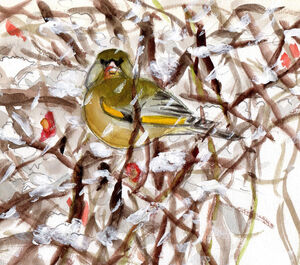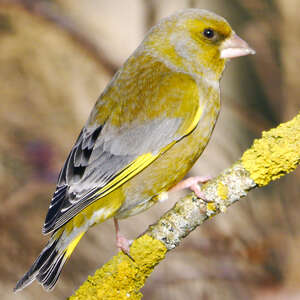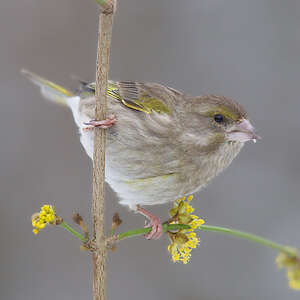European Greenfinch
Chloris chloris - Verdier d'Europe
Identification
The European Greenfinch is a plump bird about the size of a House Sparrow. Its body is compact, emphasised by the fairly short tail and chunky conical beak. The adult male overall appears yellow-green-olive. What immediately sets it apart, at rest as in flight, is the bright yellow of the wings and tail. On the wings, this yellow appears on the outer greater primary coverts, the alula and at the wrist. On view from the side this is represented by a very visible longitudinal yellow streak. On the tail, the yellow occupies the base of the rectrices except for the central ones which are blackish. Close up, the upperparts (body and small and medium coverts) appear yellow-green-olive apart from the uppertail coverts which are grey. The rump appears distinctly yellower. The greater coverts and fringes of the secondary and tertiary remiges are light grey. The underparts are of a brighter yellow-green-olive with the yellowest section being the belly. The chest may be slightly washed with brown tones. The flanks, anal area, sides of the neck and sometimes the upper part of the chest are tinged with grey. The tail is distinctly forked. The face is yellow-green with blackish lores to which the chunky conical beak (in colour horn or pink) contrasts sharply. The parotids are grey. The iris is dark brown and the legs are pink. The adult female is morphologically similar to the male, but the plumage is considerably duller. The colours are muted. The yellow only appears truly vivid on the wings, tail and rump, though less extended and intense than the male. The upperparts tinge more towards brown, with an olive hue which is more or less intense on the mantle and coverts. They are slightly streaked.In both males and females, a grey shade is noticeable on the primaries and the tertials. The underparts, in shades of brownish to greyish, appear lightly striped and have more or less of an olive tinge. The face resembles that of the male, but slightly duller. The juvenile European Greenfinch is even duller than the female, more brown, with the mantle and underparts distinctly striped.
Subspecific information 10 subspecies
- Chloris chloris chloris (n Scotland, n and c France and Norway to w Siberia)
- Chloris chloris harrisoni (Britain. except n Scotland. and Ireland)
- Chloris chloris muehlei (Serbia and Montenegro to Moldovia, Bulgaria and Greece)
- Chloris chloris aurantiiventris (s Spain through s Europe to w Greece)
- Chloris chloris madaraszi (Corsica and Sardinia)
- Chloris chloris vanmarli (nw Spain, Portugal and nw Morocco)
- Chloris chloris voousi (c Morocco and n Algeria)
- Chloris chloris chlorotica (sc Turkey to ne Egypt)
- Chloris chloris bilkevitchi (s Ukraine, the Caucasus and ne Turkey to n Iran and sw Turkmenistan)
- Chloris chloris turkestanica (s Kazakhstan to Kyrgyzstan and c Tajikistan)
Foreign names
- Verdier d'Europe,
- Verderón común,
- verdilhão-ocidental,
- Grünfink,
- zöldike,
- Groenling,
- Verdone,
- grönfink,
- Grønnfink,
- zelienka obyčajná,
- zvonek zelený,
- Grønirisk,
- viherpeippo,
- verdum europeu,
- Grænfinka,
- dzwoniec (zwyczajny),
- zaļžubīte,
- zelenec,
- Зеленушка,
- アオカワラヒワ,
- 欧金翅雀,
- grönfink,
- 歐洲金翅雀,
Voice song and call
The song of the European Greenfinch consists of the repetition of a stretched and buzzing sound chuiiiiiiii, which is not without evoking the song of the Common Chaffinch. Most of the time are interspersed between these strophes sound notes quickly repeated, yu yu yu yu yu tu tu tu tu tu tiu tiu tiu tiu tiu tsi tsi tsi tsi tsi pliu pliu pliu pliu or variants on this model. Taken individually, some have a screaming value. For example, the tu tu tu tu tu... dry and powerful, repeated very quickly, is typically the flying call. But also the monosyllabic or bisyllabic tchouii which are reminiscent of the call of other finches like the European Goldfinch or siskins, or the one from the House Sparrow. These are emitted at rest. The male can sing from an exposed singing post, the top of a tree for example, or during a fluttering flight parade.
Habitat
The European Greenfinch is a bird found in open, deciduous or mixed tree habitats. During the breeding season, it looks for places with trees and shrubs but not too densely planted, edges, forest clearings and regrowth, plantations, hedgerows, linear tree hedges along roads and waterways, riparian forests along water bodies, parks and gardens, orchards, cemeteries, etc.
Behaviour character trait
The European Greenfinch is a common bird. Very human friendly, it does not fear humans and is quite well-known to the public, as it is frequent in urban parks and gardens and is an avid winter feeder. Its strong beak makes it capable of eating hard seeds like corn grains. Like other birds, it is attracted to food sources that offer sunflower seeds. It is in these sources that it becomes quite aggressive and often chases away other birds. It is important to note that access to this food source is not necessary. Greenfinches are capable of finding seeds in the wild that allows them to survive.
However, this can be beneficial during an unusual climate episode. The species tends to be gregarious outside of breeding season. It even likes, or tolerates, the presence of other species in its vicinity. Groups of several dozen Greenfinches are frequent in fields in the winter, in the company of Chaffinches, Linnetts, Larks, and other seed eaters. The majority of Greenfinches are sedentary, and might only experienced an erratic dispersal triggered by the search for food. Nevertheless, the northernmost populations are migratory. This is observed during the autumn migrations when typicall migrator Greenfinches are counted. These birds travel in small, not very dense groups, announcing in their characteristic cry, and form nighttime roosting spots during their journey. As breeding season approaches, the groups disperse and the couples search for a nesting territory which is only weakly defended by the male, which allows for a high density of nesters and practically colonial nesting in the most favorable places such as urban parks. One can try to attract Greenfinches into their garden by encouraging bushes with dense foliage, in which it will be able to create its nest.Flight
Dietfeeding habits
The European Greenfinch mainly feeds on the seeds of very many woody and herbaceous plant species, of varying size and consistency, but also on buds and small fruits. In berries, it is mainly the enclosed seeds that are sought, the pulp being rejected, such as the fruits of Rubus. The young are fed with insect larvae during their first days of life, then with young seeds. Animal food remains very minor in the diet of adults.
Reproduction nesting
The European Greenfinch nests in very diverse places, but always in a vegetal context. Small trees and bushy shrubs, whether deciduous or evergreen, vines, ivy climbing up a wall or a trunk, are all potential supports for the nest.
Urban parks are well-provisioned with them. The female builds it, often in a fork, at a very variable height (1-20 m). This nest is a quite large but neat, made of dried stems and grass, moss and lichen, and lined internally with vegetal fibres, rootlets, hairs, feathers and sometimes elements of anthropogenic origin such as a piece of twine or paper. It is always extremely well camouflaged. The female lays 4-6 smooth and shining pale blue eggs, finely spotted. Incubation lasts around 13 days. The female is alone in incubating, but she is regularly fed by the male. The chicks are nidifugous. Both parents feed the young, first with insect larvae, and then, 5-7 days later with regurgitated seeds. The young leave the nest at 17-18 days old. Crows, jays, magpies and crows are the main predators of eggs and chicks.Geographic range
The range of the European Greenfinch is included in what is called the Western Palearctic. It is found from the Atlantic and its islands, excluding Iceland, to Western Siberia, west of Mongolia and north of Iran, and latitudinally from the north of Scandinavia to the Maghreb and north of Egypt. Nine subspecies share this rather large area. A tenth is extending into Central Asia (Tajikistan, Kyrgyzstan, Kazakhstan) thanks to the mountain ranges. The wintering area is practically the same, just with a slight shift of the northernmost populations towards the south. Some southern countries (eastern Mediterranean border, Sinai, Mesopotamia, Central Asian steppes) only host the species in winter. The species has been introduced to the Azores and to several regions in the world (South America, Australia and New Zealand).
Threats - protection
IUCN conservation status
concern
in the Wild
threatened
evaluated
The European Greenfinch is still a common and globally non-threatened species. Nevertheless, in a developed country such as France, the decline of this species is confirmed and similar to the more recent decline of the goldfinch. The French program STOC (Temporal Tracking of Common Birds) illustrates it well: The recent decline is in all respects similar to the long-term decline, of the same magnitude. This decline contrasts with what is observed in England, where the species has been slowly increasing since the early 90s. On average, the greenfinch is stable in Europe. To explain the decline, one can particularly blame the massive use of chemicals in modern, overly intensive agriculture.
Sources of information
- IOC World Bird List (v14.2), Gill, F and D Donsker (Eds). 2024-04-18.
- Le guide ornitho : Le guide le plus complet des oiseaux d'Europe, d'Afrique du Nord et du Moyen-Orient : 900 espèces, Svensson, Mullarney, Zetterstrom
- Les passereaux d'Europe, tome 2, P. Géroudet, M. Cuisin
- Finches and Sparrows, Peter Clement
- Avibase, Lepage Denis
- HBW Alive,
- xeno-canto, Sharing bird sounds from around the world,
Other sources of interest
 Specification sheet created on
08/07/2023 by Jean François
Specification sheet created on
08/07/2023 by Jean FrançoisTranslation by AI Oiseaux.net
© 1996-2025 Oiseaux.net
- Accipitriformes
- Aegotheliformes
- Anseriformes
- Apodiformes
- Apterygiformes
- Bucerotiformes
- Caprimulgiformes
- Cariamiformes
- Casuariiformes
- Charadriiformes
- Ciconiiformes
- Coliiformes
- Columbiformes
- Coraciiformes
- Cuculiformes
- Eurypygiformes
- Falconiformes
- Galliformes
- Gaviiformes
- Gruiformes
- Leptosomiformes
- Mesitornithiformes
- Musophagiformes
- Nyctibiiformes
- Opisthocomiformes
- Otidiformes
- Passeriformes
- Pelecaniformes
- Phaethontiformes
- Phoenicopteriformes
- Piciformes
- Podargiformes
- Podicipediformes
- Procellariiformes
- Psittaciformes
- Pterocliformes
- Rheiformes
- Sphenisciformes
- Steatornithiformes
- Strigiformes
- Struthioniformes
- Suliformes
- Tinamiformes
- Trogoniformes

































